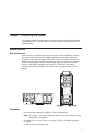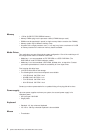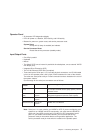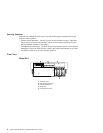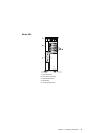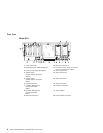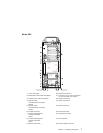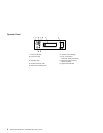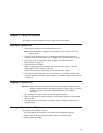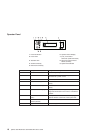
Operator Panel
v 32-character LED diagnostics display
v LEDs for power on, attention, SCSI activity, and LAN activity
v Buttons for power on, system reset, and service processor reset
System Reset
Dumps AIX (if dump is enabled) and reboots.
Service Processor Reset
Resets the service processor (standby mode).
Input/Output Ports
v One 25-pin parallel
v Keyboard
v Mouse
v Two Ultra3 SCSI (one to internal 4-pack disk drive backplane, one to external VHDCI
mini 68-pin port)
v Integrated Drive Electronics (IDE)
v Two 10/100 Ethernet (IEEE 802.3 compliant)
v Three serial ports. Serial port 1 (S1) has two physical connectors, one RJ-48 located
in front on the operator panel, and a 9-pin D-shell located on the rear of the chassis.
The other two serial ports are 9-pin D-shell connectors and are located on the rear of
the system chassis.
Current usage for the serial port connectors are as follows:
Serial Port
Number
Location Applicable Usage Examples
Serial Port 1 (S1
Front)
Operator Panel Service Agent, PDA System Management Applications
(for example: handheld devices, laptop sytems), Service
Processor menus
Serial Port 1 (S1
Rear)
Rear of the
System
Service Processor menus, Service Agent, PDA System
Management Applications (interface cable required)
Serial Port 2 (S2) Rear of the
System
Service Processor menus, HACMP
Serial Port 3 (S3) Rear of the
System
HACMP, UPS, and Modems
Note: Serial port 1 is never used to run HACMP or UPS. If you are configuring your
system to run HACMP and UPS concurrently, you must connect HACMP to
serial port 2 and UPS to serial port 3.
Do Not
run UPS connected to serial
port 2. If you decide to diconnect HACMP, you
must
reset the service
processor reset pin-hole switch before running another application. The
service processor reset pin-hole switch is located on the operator panel.
Chapter 1. Introducing the System 3









